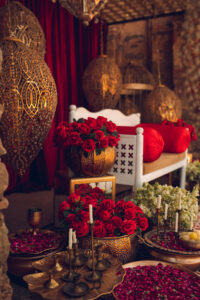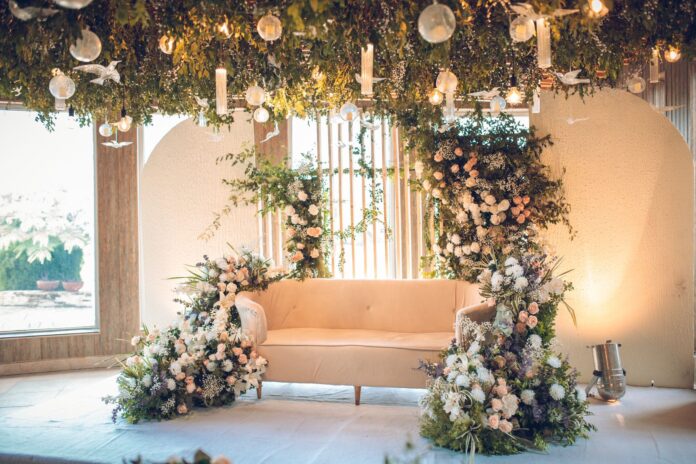There is a frenzy in the air. A young team of set designers is running frantically with flowers and other props; a supervisor screaming on their heads to do better, run faster. Panic and hysteria take centre stage as the DJ in the background carries out his sound check for both music and mic. Camera people navigate through ideal spots to create the perfect frames. The star of the show is getting ready in her vanity room, with designated best friends to constantly reassure the look and makeup. There are some last minute mishaps, of course, and these must be fixed before the final walk. As soon as the curtains go up and the spotlight shines bright, the 10-minute entrance walk seems to roll out of a staircase from heaven. That’s the thing about a good stage performance, the audience cannot tell what went on behind the curtains. There are lights, camera and action.
But this is not a film set, this is a Pakistani wedding.
Just like in a film, a lot of time, money and energy goes behind a Pakistani wedding. Getting hitched does not come cheap. In fact, it’s the investment of a lifetime, and epitome of a neoliberal dream. It sells the idea that if money can’t buy happiness, it can at least pay for the perfect wedding.
“So we are two siblings and my parents saved separately for both of us. We always knew there was a certain amount we could use for our higher education, setting up a business or for any other thing. I got a good job after my undergrad and didn’t want to study further, so we decided to utilise my portion of savings for my wedding,” mentioned Haya Khurram whose nikkah ceremony alone amounted to more than Rs 2 million in December 2021. “My parents had been planning my wedding since my childhood. I’m the only daughter so my parents made sure that all my wishes were fulfilled,” she continued.

How much does a happily ever after cost?
There are a lot of costs that go into the wedding of your dreams. There is not sufficient documentation of the wedding industry in Pakistan but according to Karachi-based bloggers and wedding curators who have been working in the wedding business since a decade, the industry was worth Rs 900 billion per annum in 2013, of which Rs 168 million was earned in Karachi alone. This means that the urban centres contribute the most to the industry.
To know what current costs in the market are, Profit reached out to Hanif Rajpoot, the oldest event planner of Islamabad. “Let’s consider an average upper-middle income household wedding in the city with at least 250 guests. We charge Rs 2500 per person. This cost includes the venue and the food. Because Islamabad is not a wedding hub, we have between 10,000-15,000 weddings a year. What it means for us is that at a minimum we earn about Rs 6.25 billion (250 x 2,500 x 10,000). This is of course a conservative number and doesn’t include decor costs, which is something that tends to go up more than the food,” explained Salman Ashraf, CEO Hanif Rajpoot.
From the customer’s point of view a typical upper-middle class Islamabadi family pays Rs 1-1.5 million for a two day event. Then there are other costs as well, such as decor, accommodation, dress, photographers. The food costs usually amount to just 20% of the entire budget.
“In a Rs 10 million wedding, 6 million will go just into decor, 3 million into food and 1 million into miscellaneous things. The ratio remains almost the same as the millions multiply in the budget,” explained Ubaid ur Rahman, Head of Operations at Hanif Rajpoot.

Profit also reached out to a Karachi-based wedding planner who wishes to stay anonymous. During a conversation with her, she said that among the big industrialists’ families spending Rs 50-60 million is not out of the ordinary. At such an event, the per head cost is easily Rs 5000. The menu includes all sorts of dishes from seafood to BBQ to Italian to continental items. The decor cost is charged separately, which can go up to about Rs 8 million per event depending on what the client wants. The decor is set differently for each event, for example, for Mehndi or Sangeet functions the decor is custom designed and so additional costs add up. Similarly, an average wedding of this scale has three major events at least with these costs, and other smaller events for which charges differ.
The big shot weddings
Happiness also means different things for different families. It would seem that the family’s occupation defines the kind of wedding they would prefer. In Islamabad, flashy weddings are not a norm. It seems that the ‘rich elite’ is mainly the educated, bureaucratic class who make calculated decisions while spending. “The biggest wedding in Islamabad is around Rs 10-20 million. These are mostly the weddings of top army families,” smirked Rahman.
It is not so for the business community. Those are an entirely different ball game. The wedding market in Islamabad is very different from other cities. The most expensive wedding in Islamabad would cost Rs 20 million at maximum, but for those belonging to business families, mostly in Lahore, Karachi and even Sialkot and Gujranwala, spending Rs 50-60 million on a wedding is not uncommon.
“You know what the Lahore culture is?” pointed out Ashraf who also has expertise in catering big weddings in other cities. “There are at least a 100 families in Lahore who are competing against each other. It’s common practice that a family reaches out to the caterer and asks the amount a certain business family spent on its wedding. We tell them that they spent Rs 50 million, they quote us 10 million higher and ask us to arrange a better wedding.”
Conversely, the trend of hosting smaller weddings is rapidly increasing. Gone are the days when a wedding function would have about a 1000 guests where most of the guests are meeting the couple for the first and last time. “We wanted a destination wedding for my sister-in-law mainly because we wanted to get out of Karachi and invite only those people who could make it. This would give us an easy bail out for keeping an intimate function with just close friends and family,” said Laiba Khan, whose in-laws run a successful leather tannery business within and outside of Pakistan. She said that the family had booked Kempinski resort in Turkey for December 2021 for the wedding. They had made a down payment estimating around Rs 2 million, but eventually had to change plans as the omicron virus spread and having a wedding party became a major health risk. “We were not getting a refund for the payment so the close family just went to the resort and had a mini family vacation,” she continued.

However the wedding did take place, just a lot more expensive than originally planned. The family decided to have the wedding in London in the summer of 2022. Khan’s in-laws paid 1000 pounds per night per apartment in central London. “We had to pay huge costs for accommodation which became a lot more than the estimate of the destination wedding in Turkey. But we had no other choice since everything was so last minute,” mentioned Khan. Later, during the conversation Khan mentioned that her family business hit major lows during covid lockdown and then also due to inflation but the wedding was still celebrated lavishly because the bride was the last sibling in the family and it was a special event for everyone.
Although it seems like money is being thrown blindly at lavish weddings, a lot of calculations go behind each detail. In a conversation with Areej Ammar, who got married in the summer of 2022, it was learned that weddings are a big opportunity for the country’s top artists who are invited to perform. Ammar’s in-laws managed the Sangeet function and looked for top entertainers in the industry to perform. “We were trying to cut costs, that’s why we called Ali Zafar who only charged somewhere around Rs 4-5 million. Our other options were Rahat Fateh Ali Khan and Atif Aslam but they were asking for approximately Rs 17 million for the same duration. I was not too big on spending so I agreed to Ali Zafar even though I’m not proud of it,” she added.
While listing the costs of Ammar’s wedding, Profit learned that her in-laws spent Rs 20 million for her jewellery alone. Ammar, who herself belongs to a more middle-class family, said that she did not want an extravagant wedding so the functions from her parents’ side were small and held at home. On the other hand, the two events held by her in-laws amounted to Rs 7.5 million. She was hesitant about the detailed costs of her wedding. Upon asking about the dress, she mentioned that since she knew the designer personally she got a discount and got two bridal dresses made within just a month. The designer, her best friend joked, is one of the best female bridal designers in the country. On her best friend’s insistence to open up, Ammar did point out that the costs were vaguely around Rs 1 million for each dress. Ammar wasn’t the happiest with a huge wedding. She mentioned that although it was huge according to her standards, for her in-laws, who own a textile and cosmetics industry, the spending was conservative. “My husband’s chacha said that I was a good child as I did not have any expenses,” she said.
Did the inflation have any impact?
A good way to measure any industry is to see its performance in times of severe economic crisis. Pakistan currently faces a double digit inflation, owing to rupee depreciation and global energy crisis. Inflation is essentially the rise in prices of various things over a set period of time. In August, Pakistan faced a historical 27% inflation, the highest since the 1970s.
Just like any other business, wedding planners are also struggling with rising costs. “The food costs have skyrocketed. For example, just a year ago a 1600 litre cooking oil tin used to cost Rs 2700 but the same tin costs Rs 9700 now. So our costs have increased three times but per head prices have not increased in the same way. Before inflation, per head price was around Rs 1000-1500 and now it’s Rs 2500. What we have noticed is that families are cutting down their guest lists but do not want to compromise on food. So we are the ones who have to let go of economies of scale and cater to a lesser number of guests with the same items,” said Rahman, while explaining the impact on Islamabad’s wedding market.

A lot of families are trying to save up on the costs where they can. For example, a lot of families have stopped the order of beverages for guests and sort that at home on their own. “Aunties usually try to cut costs as much as they can. They serve guests at home with drinks to avoid the per-drink cost at the venue,” said Halima Ahmed, Head of Decor at Hanif Rajpoot.
Where wedding planners are struggling, clients are pushing their budgets also. The same event at a marquee costs almost double now, mentioned Khurram. “If I have the same level of festivities for my wedding function (planned in October 2023) as I had in my nikkah, the estimated costs are about Rs 5 million, almost double,” she said. Due to rising costs her family has decided to not go as overboard as they did in nikkah and stay ‘within limits’ she said. Khurram’s family is willing to cut down on the wedding guests and decor, but food and jewellery is something the parents are not willing to compromise on, and will pay no matter what the cost.
Similarly, there are costs which even the big industrialists’ family are hesitant to pay. Khan mentioned that the family tried to cut down costs wherever they could. Her sister-in-law, the bride, found her desired wedding dress in Dubai for $10,000-12,000, which was out of the budget. That’s why she decided to fly to Canada and get the same dress made for $5000.
The average client is clearly hacking down costs, but so are many businesses, it would seem. Take the bridal couture industry for example. In a conversation with the members of staff of LAAM, an online one-stop shop for Pakistan’s designer brands, Profit learned that the bridal couture business boomed during COVID lockdown as people had all the time to scroll through the internet and create their perfect wedding dress online. This popularity is cashing today in times of economic crisis. “Many big designers such as Mohsin Naveed Ranjha and Hussain Rehar have launched low-budget collections for wedding dresses. Previously, they used to have premium collections only,” said a staff member.
The multiplier effect
While big-budget weddings become something like a performance for many families, they are also fertile soil for various businesses to sow their money trees. For example, in a recent piece on wedding photography, Profit learned that even the new ones in the field with little experience and a DSLR camera make at least Rs 20,000 per event. The higher costs can go up to Rs 250,000 a day. Because photography is one of the main elements of modern day weddings, most photographers end up making hefty amounts, similar to those earned by people working full time in the corporate sector.
But it’s not just about the lucrative service sector, but also about the low-income daily earner. From the mochi who makes khussa to the kareegar who makes embroidered pieces, from the farmer who grows flowers to the technician who manages the light, the wedding provides a source of income for many. The multiplier effect of the business was most evident in 2020, when there was a ban on weddings for the most part of the year. “The industry leaders arranged protests against government policies in the three big cities,” said Ashraf, “what we were shocked to see was the low-income daily wage workers joining us, such as the khussay-wala and gotay-wala. Their income had been impacted also.”
So if you’re looking for a clever business scheme to survive in Pakistan, think weddings! And if you’re an artist who is looking to turn their fate around, think weddings again! Despite economic hardships, bigger weddings are still happening. Now it’s not just about money, but how tastefully you can display your money. As they say, money can’t buy you class: and weddings are a perfect time to show that you have both.
(Some names have been changed to maintain anonymity of the sources)


























I just finished reading this article and I must say, it was a great read! The author did a fantastic job of capturing the intricate details and planning that goes into creating a big shot Pakistani wedding. The descriptions of the food, decorations, and attire were so vivid that I felt like I was right there at the event. I also appreciated the insight into the cultural traditions and customs that are an important part of Pakistani weddings. Overall, this was a fascinating and well-written article that offered a glimpse into a world that many of us may not be familiar with. Great job!
I was looking for another article by chance and found your article related to the one I am writing on this topic, so I think it will help a lot. I leave my blog address below. Please visit once.
온라인 카지노
j9korea.com